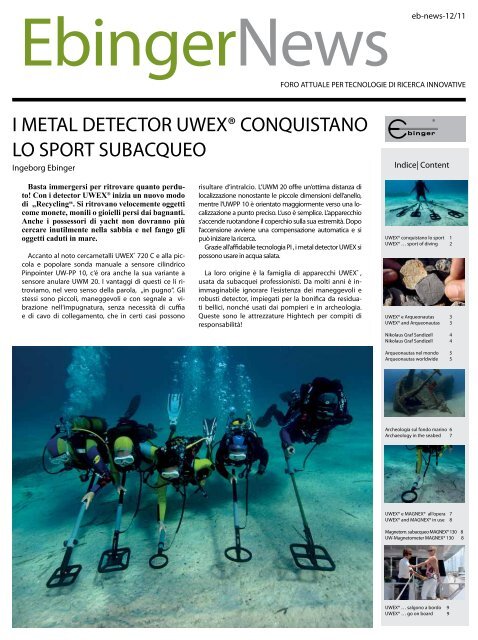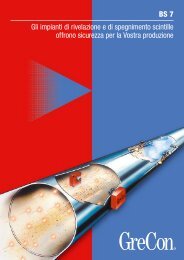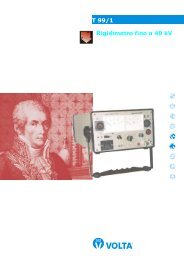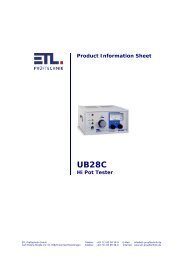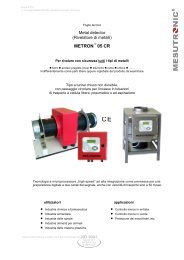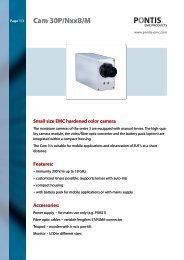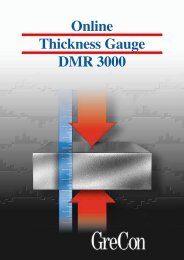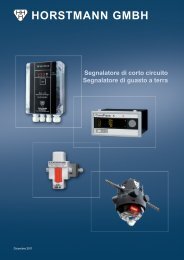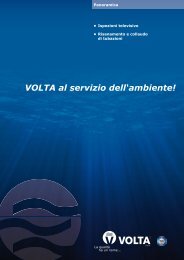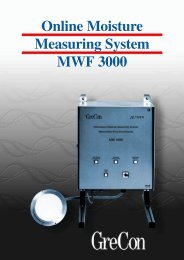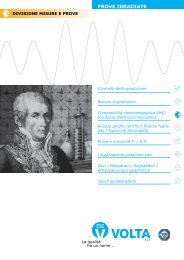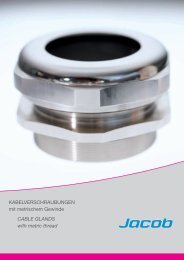Cercametalli conquistano lo sport subacqueo - Volta SpA
Cercametalli conquistano lo sport subacqueo - Volta SpA
Cercametalli conquistano lo sport subacqueo - Volta SpA
Create successful ePaper yourself
Turn your PDF publications into a flip-book with our unique Google optimized e-Paper software.
EbingerNews<br />
eb-news-12/11<br />
FORO ATTUALE PER TECNOLOGIE DI RICERCA INNOVATIVE<br />
I METAL DETECTOR UWEX® CONQUISTANO<br />
LO SPORT SUBACQUEO<br />
Ingeborg Ebinger<br />
Indice| Content<br />
Basta immergersi per ritrovare quanto perduto!<br />
Con i detector UWEX ® inizia un nuovo modo<br />
di „Recycling“. Si ritrovano ve<strong>lo</strong>cemente oggetti<br />
come monete, monili o gioielli persi dai bagnanti.<br />
Anche i possessori di yacht non dovranno più<br />
cercare inutilmente nella sabbia e nel fango gli<br />
oggetti caduti in mare.<br />
Accanto al noto cercametalli UWEX ® 720 C e alla piccola<br />
e popolare sonda manuale a sensore cilindrico<br />
Pinpointer UW-PP 10, c‘é ora anche la sua variante a<br />
sensore anulare UWM 20. I vantaggi di questi ce li ritroviamo,<br />
nel vero senso della parola, „in pugno“. Gli<br />
stessi sono piccoli, maneggevoli e con segnale a vibrazione<br />
nell‘impugnatura, senza necessità di cuffia<br />
e di cavo di collegamento, che in certi casi possono<br />
risultare d‘intralcio. L‘UWM 20 offre un‘ottima distanza di<br />
<strong>lo</strong>calizzazione nonostante le piccole dimensioni dell‘anel<strong>lo</strong>,<br />
mentre l‘UWPP 10 è orientato maggiormente verso una <strong>lo</strong>calizzazione<br />
a punto preciso. L‘uso è semplice. L‘apparecchio<br />
s‘accende ruotandone il coperchio sulla sua estremità. Dopo<br />
l‘accensione avviene una compensazione automatica e si<br />
può iniziare la ricerca.<br />
Grazie all‘affidabile tecno<strong>lo</strong>gia PI , i metal detector UWEX si<br />
possono usare in acqua salata.<br />
La <strong>lo</strong>ro origine è la famiglia di apparecchi UWEX ® ,<br />
usata da subacquei professionisti. Da molti anni è inimmaginabile<br />
ignorare l‘esistenza dei maneggevoli e<br />
robusti detector, impiegati per la bonifica da residuati<br />
bellici, nonché usati dai pompieri e in archeo<strong>lo</strong>gia.<br />
Queste sono le attrezzature Hightech per compiti di<br />
responsabilità!<br />
UWEX® <strong>conquistano</strong> <strong>lo</strong> <strong>sport</strong> 1<br />
UWEX® … <strong>sport</strong> of diving 2<br />
UWEX® e Arqueonautas 3<br />
UWEX® and Arqueonautas 3<br />
Nikolaus Graf Sandizell 4<br />
Nikolaus Graf Sandizell 4<br />
Arqueonautas nel mondo 5<br />
Arqueonautas worldwide 5<br />
Archeo<strong>lo</strong>gia sul fondo marino 6<br />
Archaeo<strong>lo</strong>gy in the seabed 7<br />
UWEX® e MAGNEX® all‘opera 7<br />
UWEX® and MAGNEX® in use 8<br />
Magnetom. <strong>subacqueo</strong> MAGNEX® 130 8<br />
UW-Magnetometer MAGNEX® 130 8<br />
1 | ebingernews<br />
UWEX® … salgono a bordo 9<br />
UWEX® … go on board 9
UWEX® METAL DETECTORS FIND THEIR WAY INTO THE<br />
SPORT OF DIVING! Ingeborg Ebinger<br />
Just dive down and find something that has been <strong>lo</strong>st! „Recycling“ of a new type –<br />
how holiday swimmers find coins or pieces of jewellery.<br />
Yachtsmen too appreciate the help of UWEX ® detectors. In the past no one knew what to<br />
do if something of value was <strong>lo</strong>st overboard and was quickly hidden in sand or mud. These<br />
times are now past!<br />
In addition to the well-known UWEX ® 720 C handheld underwater detector and the popular UW<br />
pinpointer UW-PP 10 there is now a version with ring-type search head on the market, namely the<br />
handheld UWM 20. Its advantages are „to hand“ in the truest sense of the word: the device has the<br />
very smallest dimensions and there is a vibration alarm in the handle meaning no headphones are<br />
needed and there is no disrupting cable! The UWM 20 provides an excellent detection range, the<br />
UWPP 10 exact pinpointing. Operating is easy – just a simple turn of the c<strong>lo</strong>sure part switches the<br />
detector on; compensation fol<strong>lo</strong>ws automatically and away one can go. Thanks to reliable PI techno<strong>lo</strong>gy<br />
UWEX ® detectors can be used in saltwater.<br />
The UWEX ® family of detectors had its origins in the requirements<br />
of professional divers. For many years work in the fields<br />
of exp<strong>lo</strong>sive ordnance disposal, fire brigade missions and archeo<strong>lo</strong>gy<br />
would have been unimaginable without EBINGER‘s<br />
handily sized but robust detectors. High-technical equipment<br />
for demanding tasks!<br />
2 | ebingernews
UWEX® E ARQUEONAUTAS Ingeborg Ebinger<br />
Foto: Arqueonautas<br />
I metal detector subacquei UWEX ® e MAGNEX ® sono indispensabili<br />
nell‘archeo<strong>lo</strong>gia subacquea e nel diving mirato alla ricerca professionale<br />
di tesori. Il magnetometro MAGNEX ® 130 e il cercametalli UWEX ® 725 K,<br />
entrambi per uso <strong>subacqueo</strong>, vengono ad esempio usati da ARQUEONAU-<br />
TAS WORLDWIDE S.A. (AWW) nel suo progetto indonesiano.<br />
Anche i modelli per iniziare UWEX ® 720 C e UWM 20, si possono usare con<br />
successo nelle suddette operazioni. „Il nostro Team operativo deve essere<br />
dotato della migliore attrezzatura.“, dice Nikolaus Graf Sandizell, fondatore<br />
di ARQUEONAUTAS.<br />
UWEX® AND ARQUEONAUTAS<br />
Ingeborg Ebinger<br />
Underwater metal detectors of type UWEX ® and MAGNEX ® are indispensable<br />
for the fields of underwater archeo<strong>lo</strong>gy as well as for professional<br />
diving-for-treasure work. Thus, for example, the MAGNEX ® 130 underwater<br />
magnetometer and the UWEX ® 725 K UW searching systems<br />
for sophisticated professional operations are being used by ARQUEO-<br />
NAUTAS WORLDWIDE S.A. (AWW) in its Indonesian project.<br />
The entry level models UWEX ® 720 C and UWM 20 are also being successfully<br />
used there. Graf Sandizell, the founder of ARQUEONAUTAS, states:<br />
„Our operation teams must be equipped with the very best technical<br />
equipment.“<br />
Foto: Arqueonautas Foto: Arqueonautas Foto: Arqueonautas<br />
ebingernews | 3
Nikolaus Graf Sandizell<br />
Nikolaus Graf Sandizell<br />
è dal 1995 l‘amministratore delegato e dal 2009 il presidente della Arqueonautas<br />
Worldwide.<br />
Dopo la sua baccalaurea nel 1979 in Germania, Graf Sandizell ricevette<br />
il dip<strong>lo</strong>ma in economia aziendale per il commercio internazionale, presso<br />
la Mannesmann AG (oggi Vodafone) di Düsseldorf.<br />
Dal 1982 al 1995 <strong>lo</strong> stesso prestò la sua opera presso la MAN AG in Messico<br />
e in Indonesia, e nel 1988 fu nominato direttore alle vendite per il<br />
Sud Est Asiatico. Sino al 1995 operò come amministratore delegato della<br />
MAN-Roland di Spagna e Portogal<strong>lo</strong>. Nell‘agosto 1995 fondò in Portogal<strong>lo</strong><br />
una società d‘archeo<strong>lo</strong>gia marina, per recuperare in modo commerciale,<br />
carichi di relitti di navi storiche, e al<strong>lo</strong> stesso tempo, di conservare il patrimonio<br />
culturale marittimo mondiale.<br />
Il Team Arqueonautas annovera storici, periti, archeo<strong>lo</strong>gi marini, curatori<br />
e ulteriori esperti. Nei <strong>lo</strong>ro compiti si prevede la ricerca d‘archivio,<br />
l‘ottenimento di licenze per il rilevamento e il recupero, nonché misure di<br />
ricognizione a distanza, riconoscimento, recupero, cura e conservazione dei<br />
manufatti artistici, documentazione e realizzazione di pubblicazioni scientifiche,<br />
oltre che al lavoro di relazioni pubbliche, di marketing e di vendita.<br />
Sino a oggi sono stati realizzati dei progetti di archeo<strong>lo</strong>gia subacquea,<br />
marina e sottomarina, in Portogal<strong>lo</strong>, Capo Verde, Mozambico, Vietnam, Indonesia,<br />
Brasile e in altri Paesi. Le licenze sono state ottenute per:<br />
• Capo Verde 1995 – 2002<br />
• Mozambico dal 1999<br />
• Vietnam 2004/05<br />
• Indonesia dal 2007<br />
Arqueonautas è oggi il leader a livel<strong>lo</strong> mondiale di progetti d‘archeo<strong>lo</strong>gia<br />
subacquea (marina e sottomarina), in acque basse. Sinora sono stati <strong>lo</strong>calizzati<br />
300 relitti di cui 15 recuperati. A seguito delle operazioni, sono state<br />
trovate oltre 100.000 monete e 10.000 manufatti artistici.<br />
Nell‘aprile 2007 fu lanciata la linea di moda Arqueonautas. I detentori<br />
della licenza sono la Otto-Group e la Kitaro. Il 22 dicembre 2008 Arqueonautas<br />
Worldwide (Arqueo<strong>lo</strong>gica Subacquàtica, S.A.), era quotata alla<br />
Borsa di Francoforte con un volume di cinque milioni di Euro e più di 700<br />
azionisti .<br />
Le spedizioni vengono finanziate dalla vendita di una serie di manufatti<br />
artistici, non classificati come patrimonio culturale nazionale. Ulteriori introiti<br />
li portano gli investitori, la vendita delle azioni e la commercializzazione<br />
dell linea di moda Arqueonautas.<br />
has been CEO of the Management Board of Arqueonautas Worldwide. –<br />
Arqueo<strong>lo</strong>gica Subaquática, S. A. since 1995, and Chairman since 2009.<br />
Having completed his baccalaureate in 1979 in Germany, Graf Sandizell<br />
received a business dip<strong>lo</strong>ma for International trade with Mannesmann AG<br />
(today Vodafone) in Düsseldorf.<br />
From 1982 to 1995 Graf Sandizell worked for MAN AG in Mexico and Indonesia,<br />
where he was promoted to Regional Manager for MAN-Roland AG<br />
for Southeast Asia until 1988 and thereafter he was Managing Director for<br />
MAN-Roland in Spain and Portugal until 1995. In August 1995 Graf Sandizell<br />
registered a marine archaeo<strong>lo</strong>gical company in Portugal, the company‘s objective<br />
being the recovery of the cargoes from endangered historical shipwrecks<br />
in a commercially viable manner and at the same time dedicating<br />
activities to the protection of world maritime heritage.<br />
The Arqueonautas team comprises historians, surveyors, marine archaeo<strong>lo</strong>gists,<br />
conservators and other experts involved in the company’s<br />
activities. These include archival research, obtaining survey and recovery<br />
licences, remote sensing surveys, reconnaissance, recovery, conservation<br />
of artefacts, documentation and deve<strong>lo</strong>pment of scientific publications, PR,<br />
marketing and sales.<br />
Marine archaeo<strong>lo</strong>gical projects have ben deve<strong>lo</strong>ped to date in Portugal,<br />
Cape Verde, Mozambique, Vietnam, Indonesia, Brazil and other countries<br />
and licences obtained in:<br />
• Cape Verde 1995 – 2002<br />
• Mozambique 1999 ongoing<br />
• Vietnam 2004/05<br />
• Indonesia 2007 ongoing<br />
Arqueonautas is today a world leader in commercially structured, shal<strong>lo</strong>w<br />
water marine archaeo<strong>lo</strong>gical projects. 300 shipwrecks have been discovered<br />
and these have led to 15 recovery operations which have yielded<br />
over 100,000 coins and 10,000 artefacts to date.<br />
In April 2007 the Arqueonautas fashion line was launched with the Otto-Group<br />
and Kitaro Ltd. as licence holders. On the 22. 12. 2008 Arqueonautas<br />
Worldwide – Arqueo<strong>lo</strong>gica Subacquàtica, S.A. was listed with<br />
5,000,000 shares, capital of EUR 5,000,000 and over 700 Shareholders at the<br />
Open Market on the Frankfurt Stock Exchange (QOW).<br />
Expeditions are financed through the sale of repetitive artefacts not<br />
classified as national heritage, VC Investors, the sale of shares through the<br />
Frankfurt Stock Exchange and the Arqueonautas fashion line.<br />
Foto: Arqueonautas<br />
Foto: Arqueonautas<br />
4 | ebingernews
ARQUEONAUTAS NEL MONDO<br />
Arqueonautas Worldwide, S.A. (AWW) fu fondata da Nikolaus Graf<br />
Sandizell assieme ai suoi soci nel 1995, e da al<strong>lo</strong>ra si è evoluta sino a diventare<br />
una delle istituzioni leader nel campo delle acque poco profonde<br />
(sino a ca. 60 m di profondità), che con criteri scientifici <strong>lo</strong>calizza, analizza e<br />
recupera carichi di va<strong>lo</strong>re e manufatti artistici di relitti.<br />
Il quartiere generale si trova in Portogal<strong>lo</strong>. Da lì un gruppo esperto di storici,<br />
archeo<strong>lo</strong>gi marini, sommozzatori ricercatori ed esperti di conservazione,<br />
lavora attorno al g<strong>lo</strong>bo, sotto la guida dei fondatori, a un gran numero<br />
di progetti di ricerca e di recupero.<br />
L‘attività commerciale è finanziata da investitori privati, e la licenza della linea<br />
di moda Arqueonautas si autofinanzia senza sovvenzioni statali.<br />
Lo scopo della società è il recupero e la conservazione del patrimonio<br />
culturale marino mondiale, come pure <strong>lo</strong> studio scientifico preventivo, attraverso<br />
la realizzazione di progetti marino-archeo<strong>lo</strong>gici.<br />
Foto: Arqueonautas<br />
ARQUEONAUTAS<br />
WORLDWIDE Public Research Ltd., Lissabon<br />
Nikolaus Graf Sandizell and his partners established Arqueo<strong>lo</strong>gia Subaquática,<br />
S. A. (AWW) in 1995. By now Arqueo<strong>lo</strong>gia Subaquática, S. A.,<br />
operating from Portugal, is counted amongst the leading groups for water<br />
marine archaeo<strong>lo</strong>gical projects (up to approx. 60 m depth). They recover and<br />
<strong>lo</strong>g cargo or artefacts from endangered historical shipwrecks.<br />
Sinora Arqueonautas ha trovato più di 300 relitti navali in Africa, Asia e<br />
Sudamerica. Dei 14 relitti attorno ai quali furono eseguiti gli scavi, si recuperarono<br />
oltre 10.000 manufatti artistici di notevole va<strong>lo</strong>re culturale e ca.<br />
100.000 monete. Tutto ciò fu documentato e presentato in pubblicazioni<br />
scientifiche.<br />
The experienced team comprises historians, marine archaeo<strong>lo</strong>gists, research<br />
divers and conservators who operate worldwide in a variety of<br />
search and recovery projects.<br />
AWW’s mission is the recovery of maritime heritage and advance learning<br />
through scientifically conducted marine archaeo<strong>lo</strong>gical projects and the<br />
aim of carefully projected shipwreck recoveries. The activities are financed<br />
by private investors and licence agreements of Arqueonautas fashion line<br />
without any government grants.<br />
Foto: Arqueonautas<br />
Since its beginning, AWW has discovered over 300 wreck sites in Africa,<br />
Asia and South America. Fourteen historical shipwrecks have been excavated,<br />
over 10,000 artefacts and approximately 100,000 coins and have been<br />
recovered so far. All excavations and recoveries are thoroughly documented<br />
and the results were presented in scientific publications.<br />
Foto: Arqueonautas<br />
ebingernews | 5
Relitti dai quali Arqueonautas ha eseguito recuperi | Shipwrecks excavated by Arqueonautas S. A.<br />
Arqueonautas S.A., Graf Sandizell<br />
Capo Verde (1995-2002)<br />
Dromadaire (Francia, 1762) VIC-004 22.01.96<br />
Princess Louisa (Inghilterra, 1743) MAI-006 05.06.96<br />
Hartwell (England, 1787) BOA-007 23.07.96<br />
Leijmuden (Olanda, 1770) BOA-005 20.07.96<br />
USS Yorktown (USA, 1850) MAI-011 07.08.99<br />
Schimmelmann (Danimarca, 1781) MAI-010 13.08.99<br />
Lady Burgess (Inghilterra, 1805) VAL-002 17.10.99<br />
“San Francisco” (Spagna, ca. 1650) AGO-063 24.10.99<br />
“Varandinha” (Inghilterra, ca./approx. 1850) BOA-018 18.06.00<br />
“Ilheu da Cima“ (Inghilterra, 19. sec.) BRV-006 24.02.01<br />
Guadalupe IV (Spagna, 1865) BRV-007 24.02.01<br />
Mozambico (dal 2000)<br />
Espadarte (Portogal<strong>lo</strong>, 1558) IDM-002 30.05.01<br />
N.S. Consolação (Portogal<strong>lo</strong>, 1608) IDM-003 03.07.01<br />
“Gin Wreck” (Inghilterra, XIX. cent.) IDM-010 18.07.02<br />
San Jose (Portogal<strong>lo</strong>, 1622) MOG-003 01.10.04<br />
ARCHEOLOGIA SUL FONDO MARINO<br />
Alex Mirabal, CEO/AWW<br />
L‘Arqueonautas Worldwide, S. A. sta attualmente effettuando una ricerca archeo<strong>lo</strong>gica<br />
su vasta scala nelle acque della provincia indonesiana Bangka-Belitung. La spedizione avviene<br />
in collaborazione con i ministeri del turismo e della cultura, nonché con quelli della<br />
ricerca e del<strong>lo</strong> sviluppo.<br />
Le ricerche hanno luogo nelle cosiddette aree o zone ad alta probabilità, identificate sulla<br />
scorta di documenti storici e d‘informazioni avute dai pescatori <strong>lo</strong>cali, non trascurando<br />
un‘analisi del rischio, nonché in base alla conoscenza dell‘andamento delle scogliere.<br />
Non appena si trova una zona con materiale culturale, i ricercatori eseguono la mappatura<br />
e la registrazione del ritrovamento. Un‘ispezione iniziale non altera niente ed è molto<br />
importante per la programmazione dei lavori di scavo che seguono. La stessa definisce<br />
il luogo esatto del ritrovamento, il tipo di fondale marino, <strong>lo</strong> spessore della copertura, la<br />
quantità di materiale archeo<strong>lo</strong>gico e la natura di questo. L‘Arqueonautas-Operationsteam<br />
appronta la documentazione in base a due metodi: l‘ispezione a distanza (remote sensing<br />
survey) e quella visiva in profondità.<br />
Il „metodo d‘ispezione a distanza“ è simile al rastrellamento di un prato. A tale proposito<br />
vengono utilizzati apparecchi elettronici (magnetometri, sonarscanner, rilevatori di sagoma<br />
o profiler del sottofondale) che vengono trainati in base a griglie, computerizzate e<br />
visualizzate, del sottofondo. Il Team esegue numerose misurazioni elettroniche, laddove<br />
possono trovarsi con grande probabilità dei relitti. Lo scopo principale è quel<strong>lo</strong> di <strong>lo</strong>calizzare<br />
e fare la mappatura di qualsiasi struttura anomala, che servirà per ulteriori analisi.<br />
La documentazione completa tiene conto delle condizioni metereo<strong>lo</strong>giche <strong>lo</strong>cali, del tipo<br />
d‘imbarcazione, della qualifica del conduttore del natante e di altro.<br />
6 | ebingernews
ARCHAEOLOGY IN THE SEABED<br />
Alex Mirabal, CEO/AWW<br />
Arqueonautas Worldwide S. A. is presently conducting a large-scale archaeo<strong>lo</strong>gical survey<br />
in the waters off the Bangka-Belitung province of the Republic of Indonesia. This survey<br />
is being carried out in collaboration with the Ministries of Tourism & Culture and Research<br />
& Deve<strong>lo</strong>pment.<br />
The inspections are taking place in high probability areas as indicated by historic documents<br />
as well as on the basis of information from <strong>lo</strong>cal fishermen, the analysis of marine<br />
hazards and the known outline of the reefs. Once a site with culturally valuable material<br />
has been discovered, the surveyors commence with mapping and recording it. An initial<br />
survey that does not disturb anything plays an important role in planning the subsequent<br />
excavation work. It defines the area of the site, type of seabed, thickness of the overburden,<br />
amount of archaeo<strong>lo</strong>gical material and the nature of this. The Arqueonautas operations<br />
team carries out surveys by two basic methods: remote sensing survey and visual survey.<br />
The remote sensing survey technique is commonly<br />
called “mowing the lawn”. By towing electronic equipment<br />
(magnetometers, side-scan sonars, sub-bottom profilers,<br />
etc.) over a computerized grid, the team is able to carry out<br />
extensive electronic surveys of areas with a high probability<br />
of wreck material. The primary objective is to <strong>lo</strong>cate and<br />
map any anoma<strong>lo</strong>us features for future investigation. A coverage<br />
overlap is designed to al<strong>lo</strong>w for the site conditions,<br />
weather, boat type, boat operator abilities, etc.<br />
Foto: Arqueonautas<br />
UWEX® E MAGNEX® ALL‘OPERA PRESSO ARQUEONAUTAS<br />
Alex Mirabal, CEO/AWW<br />
UWEX ® 720 C: queste sonde cercametalli sono molto buone, piccole, compatte e affidabili.<br />
Le stesse sono costruite secondo un concetto di „massima semplicità“, per ridurre il<br />
rischio di guasti durante l‘uso.<br />
La possibilità di disinserire l‘apparecchio in acqua nel momento in cui non viene utilizzato,<br />
contribuisce ad allungare la durata ovvero l‘autonomia della batteria. La distanza d‘azione o di<br />
<strong>lo</strong>calizzazione è limitata dalle contenute dimensione del sensore (anel<strong>lo</strong>). Vorremmo provare<br />
quest‘apparecchio con una sonda anulare più grande, per poter<strong>lo</strong> confrontare con i nostri attuali<br />
ELSEC‘s, in quanto un confronto non sarebbe ora molto corretto (sarebbe come confrontare<br />
2 auto, una con motore da 1,2 l e l‘altra con uno da 2,2 l)<br />
I colleghi archeo<strong>lo</strong>gi subacquei si sono così espressi:<br />
...questi apparecchi sono veramente molto buoni. A seguito delle prove effettuate, possiamo<br />
esprimere un giudizio positivo. Se si potesse fare un Test dell‘UWEX ® 720 C munito di<br />
anel<strong>lo</strong> sensore più grande e di tubo di prolunga, siamo convinti che potremmo seriamente<br />
prendere in considerazione un cambio con gli apparecchi che per lungo tempo hanno goduto<br />
del nostro favore.<br />
ebingernews | 7
UWEX® AND MAGNEX® IN USE AT ARQUEONAUTAS<br />
Alex Mirabal, CEO/AWW<br />
UWEX ® 720 C, these metal detectors are also very good. Small, compact and reliable; they<br />
are also built in a “simple” concept that diminishes the risk of damage during their use. The<br />
on-off feature extends the battery life when the metal detector is in the water but not in<br />
use.<br />
The detection range is limited though, but we think it is because of the small size of the<br />
coil. We would like to test these metal detectors with larger coils and with an extension<br />
stem in order to properly compare it with our ELSECs, because now the comparison is not<br />
balanced (is like comparing two cars, one with a 1.2cc engine and the other with 2.2cc).<br />
In the opinion of the marine archaeo<strong>lo</strong>gical divers the<br />
metal detectors are very good. We are in general quite happy<br />
with the equipment and (after testing the metal detectors<br />
again with larger coils and stems) we could seriously<br />
consider to change from our <strong>lo</strong>ng-time favored<br />
MAGNETOMETRO SUBACQUEO MAGNEX ® 130<br />
Alex Mirabal, CEO/AWW<br />
Il magnetometro <strong>subacqueo</strong> MAGNEX ® 130 è stato utilizzato a profondità tra i 13 e i 35 m.<br />
Lo stesso si è confermato valido per la ricerca a punto preciso di piccole anomalie magnetiche,<br />
nonché per determinare con precisione la posizione d‘oggetti ferromagnetici celati<br />
nel sedimento, già pre<strong>lo</strong>calizzati grossolanamente con il Geometric a traino G-882.<br />
Il MAGNEX ® 130 ha rilevato svariati oggetti sotto 4,5 m di melma. Se par<strong>lo</strong> di piccole anomalie,<br />
non mi riferisco alla <strong>lo</strong>ro ampiezza, bensì a una piccola deformazione entro uno spazio<br />
limitato del campo magnetico terrestre. Quest‘apparecchio non è adatto per l‘esame di<br />
una grande anomalia (come si ha nel caso di un grosso relitto in acciaio o di grosse lenti<br />
geo<strong>lo</strong>giche minerali).<br />
Il MAGNEX ® 130 ci è particolarmente utile per il nostro lavoro in acque melmose e su fondali<br />
a forte sedimentazione, per ritrovare anomalie rilevate prima oppure per ispezionare<br />
l‘area del relitto con forti strati di sedimento oppure di frammenti o detriti.<br />
„Siamo molto contenti di questo nuovo apparecchio!“<br />
UW-MAGNETOMETER MAGNEX ® 130<br />
Alex Mirabal, CEO/AWW<br />
This handheld magnetometer has been used four times in water depths between 13m<br />
and 35m. It has proven to be most useful in pinpointing small anomalies buried in sediment<br />
which have already been <strong>lo</strong>cated by the towed Geometric magnetometer G-882.<br />
It has already detected objects buried as deep as 4.5m under mud. When referring to<br />
„small“ anomalies I mean spatially small distortions of the terrestrial magnetic field and not<br />
small in respect of amplitude. This magnetometer is not suitable for investigating a a large<br />
anomaly (such as the wreck of a steel ship or a geo<strong>lo</strong>gic mineral lens); it was not designed<br />
for such applications.<br />
This kind of magnetometer is particularly useful for our work in muddy waters and areas<br />
with a <strong>lo</strong>t of sedimentation for the re<strong>lo</strong>cating of previously pinpointed anomalies and also<br />
for investigating wreck sites with a large amount of debris and a thick layer of sediment.<br />
„We are very happy with this new device!“<br />
8 | ebingernews<br />
Foto: Arqueonautas
Termine | Events<br />
Boot Düsseldorf<br />
22. 01. – 30. 01. 2011<br />
Fachtagung Kampfmittelräumung<br />
21. 02. – 22. 02. 2011 | Bad Kissingen<br />
Fachtagung Kampfmittelbeseitigung<br />
27. 01. – 28. 01. 2011 | Dresden<br />
IWA<br />
11. 03. – 14. 03. 2011 | Nürnberg<br />
Europoltech<br />
13. 04. – 15. 04. 2011 | Warschau<br />
Milipol Paris<br />
18. 09. – 21. 09. 2011<br />
I METAL DETECTOR UWEX® SALGONO A BORDO<br />
Gli yacht, possono essere tecnicamente perfetti e dotati di<br />
tutti gli accorgimenti più raffinati, ma appena qualcosa cade<br />
in mare, l‘equipaggio rimane disorientato. Che fare ora? La<br />
maggior parte degli oggetti affonda e scompare nella sottile<br />
sabbia o nel fango. La corrente sottomarina fa il resto. La soluzione<br />
la offre il metal detector UWEX!<br />
Oggetti metallici di va<strong>lo</strong>re oppure accessori del<strong>lo</strong> yacht<br />
(oro<strong>lo</strong>gi, ornamenti, ancore etc.) caduti in mare, si possono<br />
ritrovare con un cercametalli UWEX ® . Ancora di più: fatene<br />
un evento con il motto „Cerca e trova“ o „Caccia al tesoro“<br />
per i possessori degli oggetti e per gli ospiti. Fate inoltre in<br />
modo da avere più sicurezza a bordo! Una sonda manuale<br />
per l‘ispezione delle persone, del bagaglio o di altro carico,<br />
Vi aiuterà nel compito.<br />
UWEX® METAL DETECTORS GO ON BOARD<br />
The yacht may be technically valuable and fully equipped,<br />
but as soon as something went overboard the crew is clueless.<br />
What to do? Most objects will sink and disappear in<br />
the silt or fine sand of the seabed. The UWEX ® metal detector<br />
is the answer!<br />
Lost items can be <strong>lo</strong>cated: Valuable objects with metal content<br />
or expensive yacht equipment that went overboard<br />
can be <strong>lo</strong>cated (watches, jewellery, even anchors etc.). Have<br />
more fun & action: Search and <strong>lo</strong>cate – Treasure hunting for<br />
owners, guests and charter<br />
Suits for security checks of visitors attending public maritime<br />
events.<br />
Professional use worldwide UWEX ® underwater metal detectors<br />
<strong>lo</strong>cate all metal, are saltwater compatible and pressure<br />
water proof to 60 m. They also suit for normal land<br />
use. UWEX ® detectors are welcome and widely accepted<br />
by professional divers, police and customs, military or in<br />
I cercametalli subacquei UWEX ® rilevano tutti i metalli, e<br />
si possono usare in acqua salata. Sono stagni sino a una<br />
profondità di ca. 60 m, e alcuni modelli sono adatti per<br />
l‘impiego terrestre. Questi detector UWEX ® sono usati<br />
quotidianamente dalle forze militari, di polizia, di dogana,<br />
nonché nelle attività di archeo<strong>lo</strong>gia subacquea.<br />
L‘ UWEX ® è un prodotto della EBINGER ® Metal Detector,<br />
un nome ricorrente nel mondo nella ricerca umanitaria<br />
di mine, EOD, bonifica da residuati bellici, controlli<br />
di sicurezza negli areoporti, crimino<strong>lo</strong>gia, ricerca e archeo<strong>lo</strong>gia.<br />
underwater archaeo<strong>lo</strong>gy.UWEX ® is a fine product of<br />
the EBINGER ® range of metal detectors. The EBINGER ®<br />
brand, is internationally renowned for trend setting<br />
techno<strong>lo</strong>gy in humanitarian mine action, internal security,<br />
forensic police work and archaeo<strong>lo</strong>gy.<br />
Impressum | Imprint<br />
Herausgeber | Editor<br />
Ebinger Prüf- und Ortungstechnik GmbH<br />
Hansestraße 13 | 51149 Co<strong>lo</strong>gne | Germany<br />
Phone +49(o)2203 977100<br />
Fax +49(o)2203 36062<br />
info@ebinger.org | www. ebingergmbh.de<br />
Ebinger GmbH | Niederlassung Eifel<br />
Vulkanstraße 14 | 54578 Wiesbaum<br />
Germany<br />
Phone +49(o)6593 998940<br />
Fax +49(o)6593 9989450<br />
eifel@ebingergmbh.de<br />
Redaktionsleitung | Editorial management<br />
Klaus Ebinger | Ingeborg Ebinger<br />
Theodor Steinbüchel | Oliver Bartsch<br />
Redaktion | Editorial staff<br />
Klaus Ebinger | Oliver Bartsch<br />
Ingeborg Ebinger<br />
Theodor Steinbüchel | Frank Dietsch<br />
Nikolas Kraemer<br />
Art direction & layout<br />
Digital Artwork, Bonn<br />
Fotos | Photos<br />
EBINGER | O. Bartsch | F. Dietsch<br />
C. Gerigk | Arqueonautas S. A. | fotolia<br />
Druck | Printing<br />
Druckerei Engelhardt GmbH, Neunkirchen-<br />
Seelscheid<br />
Vasen Big Print, Hennef<br />
Für Druckfehler wird nicht gehaftet. Änderungen<br />
in Beschreibungen und Abbildungen<br />
bleiben ausdrücklich vorbehalten. Gedruckt in<br />
Deutschland.<br />
Subject to change. Printed in Germany.<br />
EB-NEWS-D-E-3M-01-11<br />
9 | ebingernews


